EFFECT OF DIFFERENT FACTORS IN ENZYME ACTIVITY.
VerifiedAdded on 2022/08/16
|11
|2347
|10
AI Summary
Contribute Materials
Your contribution can guide someone’s learning journey. Share your
documents today.
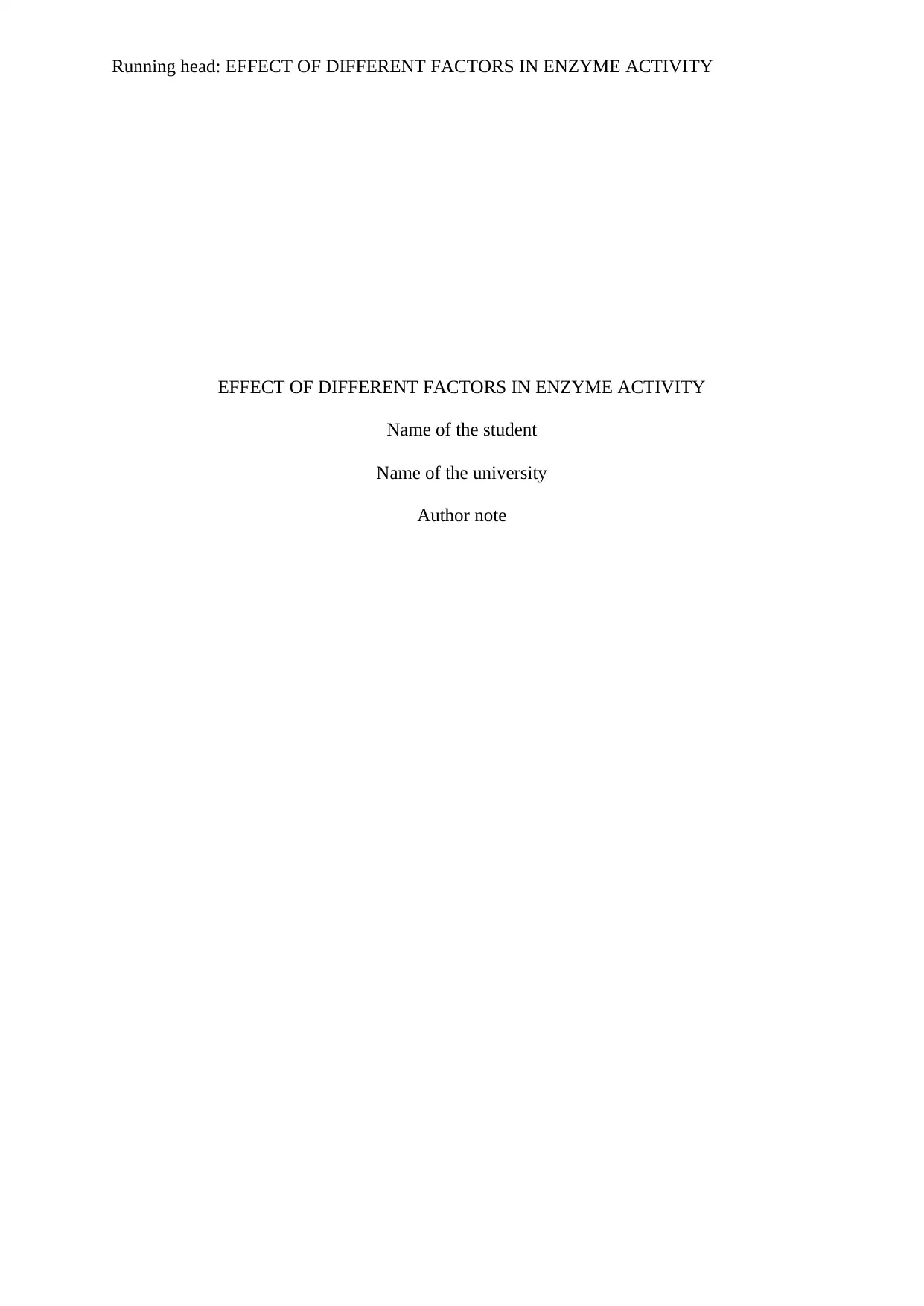
Running head: EFFECT OF DIFFERENT FACTORS IN ENZYME ACTIVITY
EFFECT OF DIFFERENT FACTORS IN ENZYME ACTIVITY
Name of the student
Name of the university
Author note
EFFECT OF DIFFERENT FACTORS IN ENZYME ACTIVITY
Name of the student
Name of the university
Author note
Secure Best Marks with AI Grader
Need help grading? Try our AI Grader for instant feedback on your assignments.
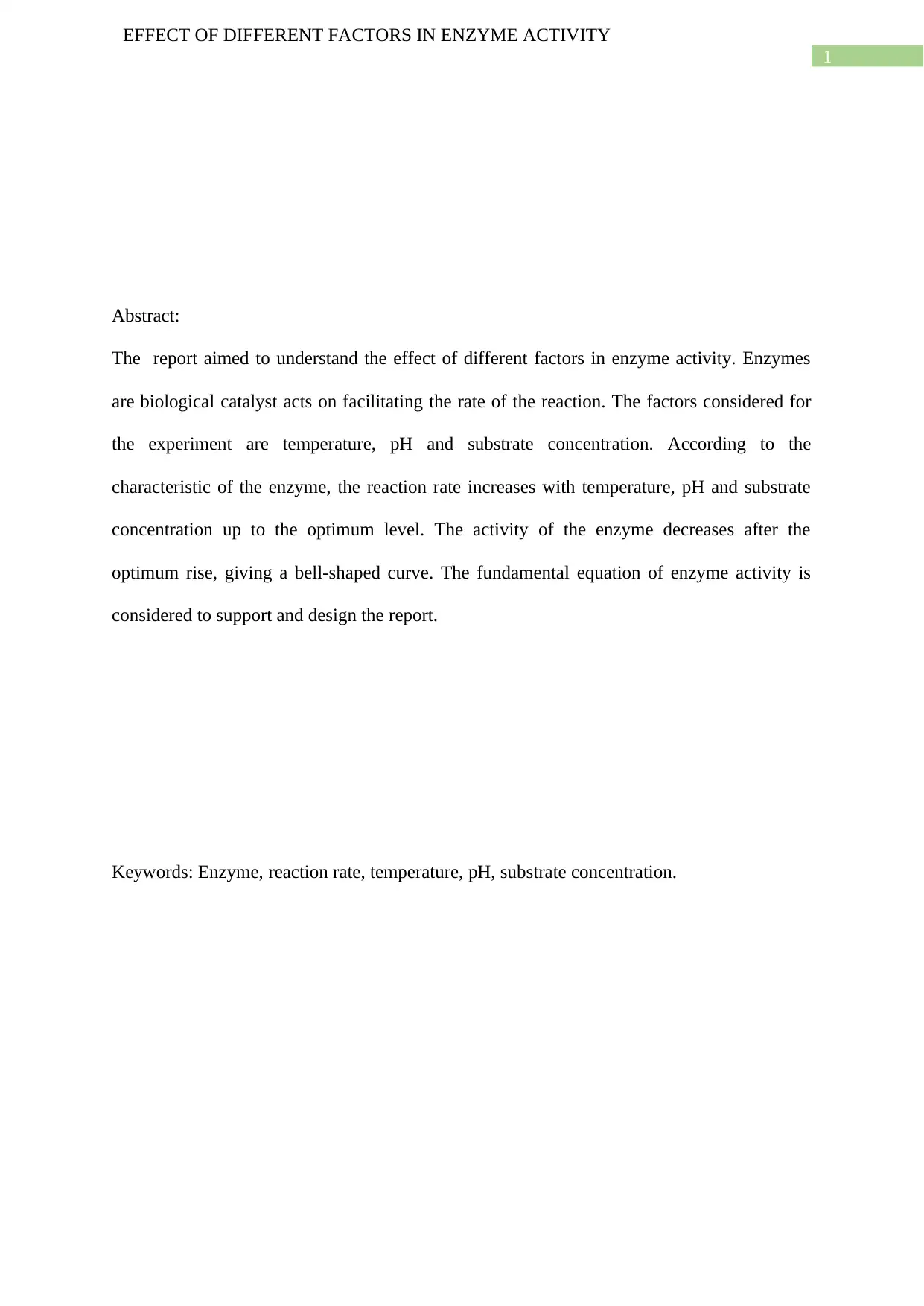
1
EFFECT OF DIFFERENT FACTORS IN ENZYME ACTIVITY
Abstract:
The report aimed to understand the effect of different factors in enzyme activity. Enzymes
are biological catalyst acts on facilitating the rate of the reaction. The factors considered for
the experiment are temperature, pH and substrate concentration. According to the
characteristic of the enzyme, the reaction rate increases with temperature, pH and substrate
concentration up to the optimum level. The activity of the enzyme decreases after the
optimum rise, giving a bell-shaped curve. The fundamental equation of enzyme activity is
considered to support and design the report.
Keywords: Enzyme, reaction rate, temperature, pH, substrate concentration.
EFFECT OF DIFFERENT FACTORS IN ENZYME ACTIVITY
Abstract:
The report aimed to understand the effect of different factors in enzyme activity. Enzymes
are biological catalyst acts on facilitating the rate of the reaction. The factors considered for
the experiment are temperature, pH and substrate concentration. According to the
characteristic of the enzyme, the reaction rate increases with temperature, pH and substrate
concentration up to the optimum level. The activity of the enzyme decreases after the
optimum rise, giving a bell-shaped curve. The fundamental equation of enzyme activity is
considered to support and design the report.
Keywords: Enzyme, reaction rate, temperature, pH, substrate concentration.
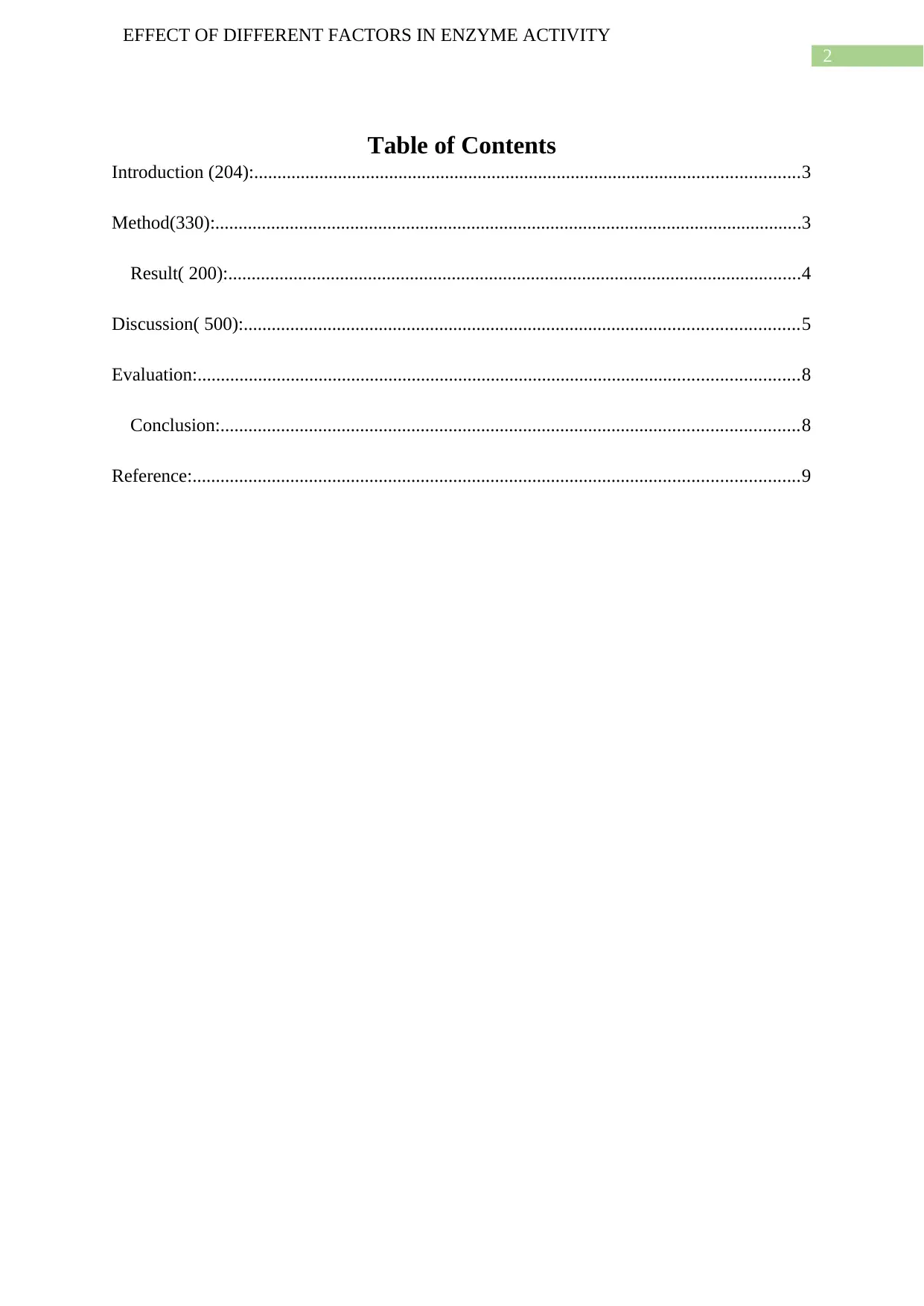
2
EFFECT OF DIFFERENT FACTORS IN ENZYME ACTIVITY
Table of Contents
Introduction (204):.....................................................................................................................3
Method(330):..............................................................................................................................3
Result( 200):...........................................................................................................................4
Discussion( 500):.......................................................................................................................5
Evaluation:.................................................................................................................................8
Conclusion:............................................................................................................................8
Reference:..................................................................................................................................9
EFFECT OF DIFFERENT FACTORS IN ENZYME ACTIVITY
Table of Contents
Introduction (204):.....................................................................................................................3
Method(330):..............................................................................................................................3
Result( 200):...........................................................................................................................4
Discussion( 500):.......................................................................................................................5
Evaluation:.................................................................................................................................8
Conclusion:............................................................................................................................8
Reference:..................................................................................................................................9
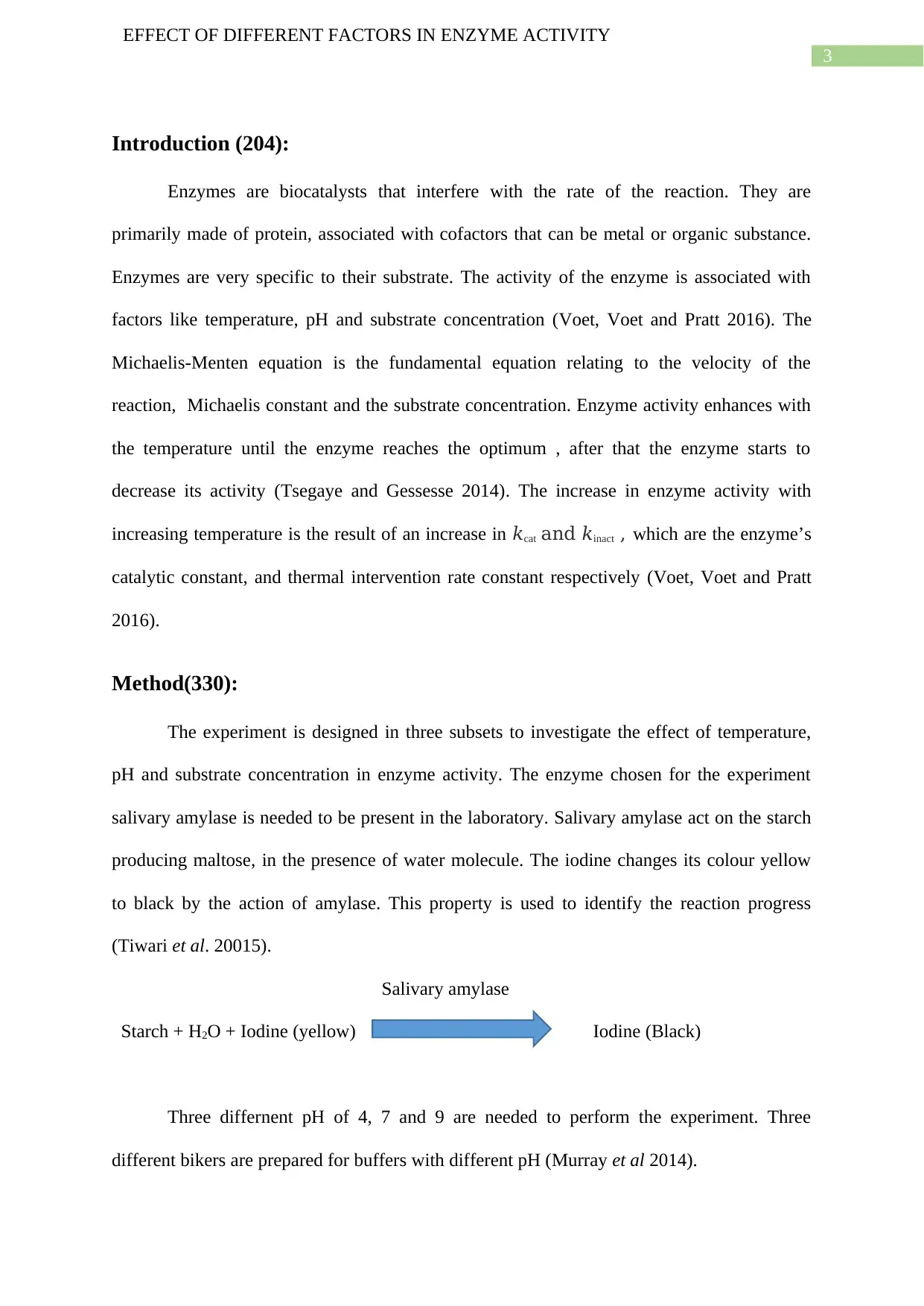
3
EFFECT OF DIFFERENT FACTORS IN ENZYME ACTIVITY
Introduction (204):
Enzymes are biocatalysts that interfere with the rate of the reaction. They are
primarily made of protein, associated with cofactors that can be metal or organic substance.
Enzymes are very specific to their substrate. The activity of the enzyme is associated with
factors like temperature, pH and substrate concentration (Voet, Voet and Pratt 2016). The
Michaelis-Menten equation is the fundamental equation relating to the velocity of the
reaction, Michaelis constant and the substrate concentration. Enzyme activity enhances with
the temperature until the enzyme reaches the optimum , after that the enzyme starts to
decrease its activity (Tsegaye and Gessesse 2014). The increase in enzyme activity with
increasing temperature is the result of an increase in kcat and kinact , which are the enzyme’s
catalytic constant, and thermal intervention rate constant respectively (Voet, Voet and Pratt
2016).
Method(330):
The experiment is designed in three subsets to investigate the effect of temperature,
pH and substrate concentration in enzyme activity. The enzyme chosen for the experiment
salivary amylase is needed to be present in the laboratory. Salivary amylase act on the starch
producing maltose, in the presence of water molecule. The iodine changes its colour yellow
to black by the action of amylase. This property is used to identify the reaction progress
(Tiwari et al. 20015).
Salivary amylase
Starch + H2O + Iodine (yellow) Iodine (Black)
Three differnent pH of 4, 7 and 9 are needed to perform the experiment. Three
different bikers are prepared for buffers with different pH (Murray et al 2014).
EFFECT OF DIFFERENT FACTORS IN ENZYME ACTIVITY
Introduction (204):
Enzymes are biocatalysts that interfere with the rate of the reaction. They are
primarily made of protein, associated with cofactors that can be metal or organic substance.
Enzymes are very specific to their substrate. The activity of the enzyme is associated with
factors like temperature, pH and substrate concentration (Voet, Voet and Pratt 2016). The
Michaelis-Menten equation is the fundamental equation relating to the velocity of the
reaction, Michaelis constant and the substrate concentration. Enzyme activity enhances with
the temperature until the enzyme reaches the optimum , after that the enzyme starts to
decrease its activity (Tsegaye and Gessesse 2014). The increase in enzyme activity with
increasing temperature is the result of an increase in kcat and kinact , which are the enzyme’s
catalytic constant, and thermal intervention rate constant respectively (Voet, Voet and Pratt
2016).
Method(330):
The experiment is designed in three subsets to investigate the effect of temperature,
pH and substrate concentration in enzyme activity. The enzyme chosen for the experiment
salivary amylase is needed to be present in the laboratory. Salivary amylase act on the starch
producing maltose, in the presence of water molecule. The iodine changes its colour yellow
to black by the action of amylase. This property is used to identify the reaction progress
(Tiwari et al. 20015).
Salivary amylase
Starch + H2O + Iodine (yellow) Iodine (Black)
Three differnent pH of 4, 7 and 9 are needed to perform the experiment. Three
different bikers are prepared for buffers with different pH (Murray et al 2014).
Secure Best Marks with AI Grader
Need help grading? Try our AI Grader for instant feedback on your assignments.
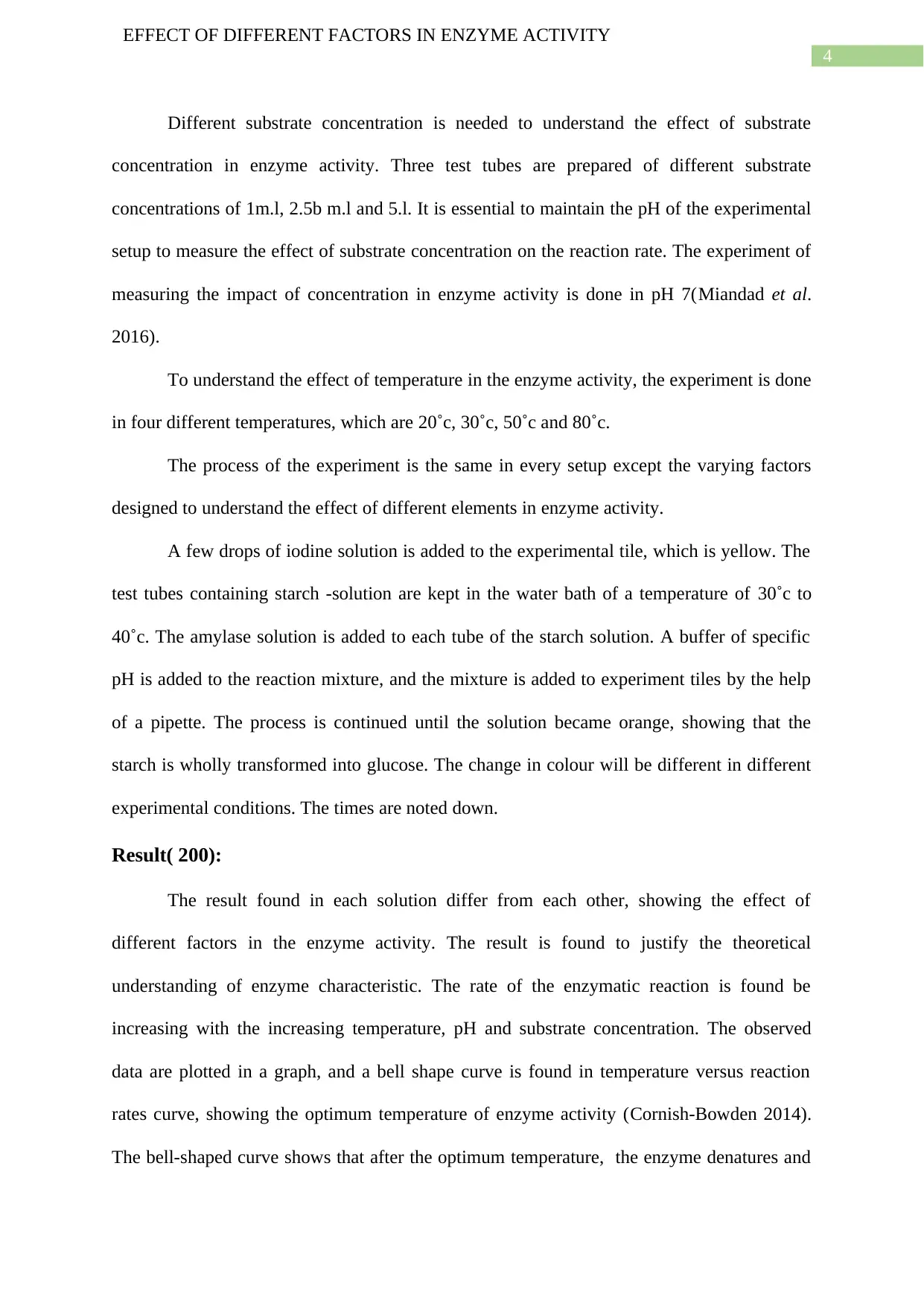
4
EFFECT OF DIFFERENT FACTORS IN ENZYME ACTIVITY
Different substrate concentration is needed to understand the effect of substrate
concentration in enzyme activity. Three test tubes are prepared of different substrate
concentrations of 1m.l, 2.5b m.l and 5.l. It is essential to maintain the pH of the experimental
setup to measure the effect of substrate concentration on the reaction rate. The experiment of
measuring the impact of concentration in enzyme activity is done in pH 7(Miandad et al.
2016).
To understand the effect of temperature in the enzyme activity, the experiment is done
in four different temperatures, which are 20˚c, 30˚c, 50˚c and 80˚c.
The process of the experiment is the same in every setup except the varying factors
designed to understand the effect of different elements in enzyme activity.
A few drops of iodine solution is added to the experimental tile, which is yellow. The
test tubes containing starch -solution are kept in the water bath of a temperature of 30˚c to
40˚c. The amylase solution is added to each tube of the starch solution. A buffer of specific
pH is added to the reaction mixture, and the mixture is added to experiment tiles by the help
of a pipette. The process is continued until the solution became orange, showing that the
starch is wholly transformed into glucose. The change in colour will be different in different
experimental conditions. The times are noted down.
Result( 200):
The result found in each solution differ from each other, showing the effect of
different factors in the enzyme activity. The result is found to justify the theoretical
understanding of enzyme characteristic. The rate of the enzymatic reaction is found be
increasing with the increasing temperature, pH and substrate concentration. The observed
data are plotted in a graph, and a bell shape curve is found in temperature versus reaction
rates curve, showing the optimum temperature of enzyme activity (Cornish-Bowden 2014).
The bell-shaped curve shows that after the optimum temperature, the enzyme denatures and
EFFECT OF DIFFERENT FACTORS IN ENZYME ACTIVITY
Different substrate concentration is needed to understand the effect of substrate
concentration in enzyme activity. Three test tubes are prepared of different substrate
concentrations of 1m.l, 2.5b m.l and 5.l. It is essential to maintain the pH of the experimental
setup to measure the effect of substrate concentration on the reaction rate. The experiment of
measuring the impact of concentration in enzyme activity is done in pH 7(Miandad et al.
2016).
To understand the effect of temperature in the enzyme activity, the experiment is done
in four different temperatures, which are 20˚c, 30˚c, 50˚c and 80˚c.
The process of the experiment is the same in every setup except the varying factors
designed to understand the effect of different elements in enzyme activity.
A few drops of iodine solution is added to the experimental tile, which is yellow. The
test tubes containing starch -solution are kept in the water bath of a temperature of 30˚c to
40˚c. The amylase solution is added to each tube of the starch solution. A buffer of specific
pH is added to the reaction mixture, and the mixture is added to experiment tiles by the help
of a pipette. The process is continued until the solution became orange, showing that the
starch is wholly transformed into glucose. The change in colour will be different in different
experimental conditions. The times are noted down.
Result( 200):
The result found in each solution differ from each other, showing the effect of
different factors in the enzyme activity. The result is found to justify the theoretical
understanding of enzyme characteristic. The rate of the enzymatic reaction is found be
increasing with the increasing temperature, pH and substrate concentration. The observed
data are plotted in a graph, and a bell shape curve is found in temperature versus reaction
rates curve, showing the optimum temperature of enzyme activity (Cornish-Bowden 2014).
The bell-shaped curve shows that after the optimum temperature, the enzyme denatures and
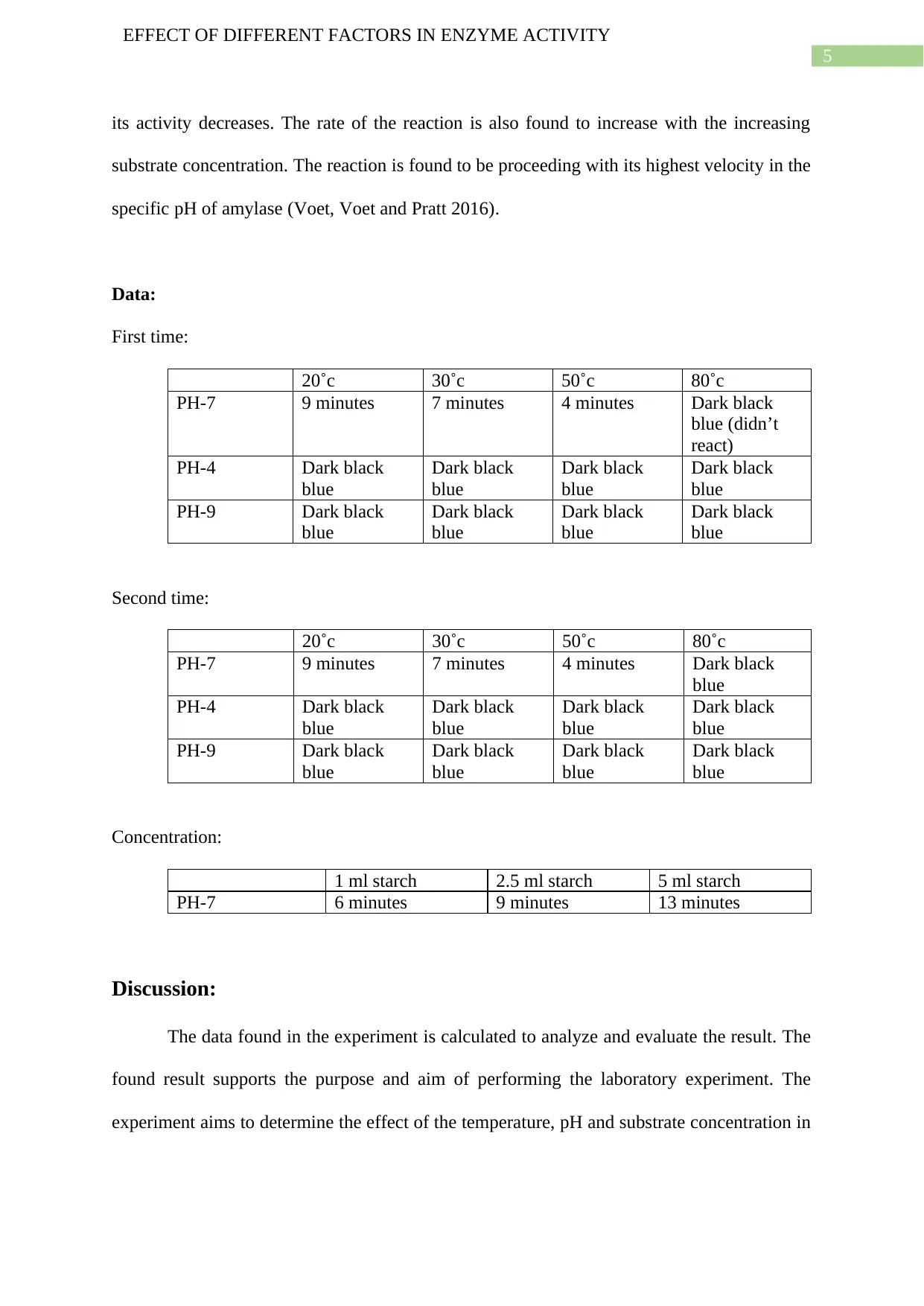
5
EFFECT OF DIFFERENT FACTORS IN ENZYME ACTIVITY
its activity decreases. The rate of the reaction is also found to increase with the increasing
substrate concentration. The reaction is found to be proceeding with its highest velocity in the
specific pH of amylase (Voet, Voet and Pratt 2016).
Data:
First time:
20˚c 30˚c 50˚c 80˚c
PH-7 9 minutes 7 minutes 4 minutes Dark black
blue (didn’t
react)
PH-4 Dark black
blue
Dark black
blue
Dark black
blue
Dark black
blue
PH-9 Dark black
blue
Dark black
blue
Dark black
blue
Dark black
blue
Second time:
20˚c 30˚c 50˚c 80˚c
PH-7 9 minutes 7 minutes 4 minutes Dark black
blue
PH-4 Dark black
blue
Dark black
blue
Dark black
blue
Dark black
blue
PH-9 Dark black
blue
Dark black
blue
Dark black
blue
Dark black
blue
Concentration:
1 ml starch 2.5 ml starch 5 ml starch
PH-7 6 minutes 9 minutes 13 minutes
Discussion:
The data found in the experiment is calculated to analyze and evaluate the result. The
found result supports the purpose and aim of performing the laboratory experiment. The
experiment aims to determine the effect of the temperature, pH and substrate concentration in
EFFECT OF DIFFERENT FACTORS IN ENZYME ACTIVITY
its activity decreases. The rate of the reaction is also found to increase with the increasing
substrate concentration. The reaction is found to be proceeding with its highest velocity in the
specific pH of amylase (Voet, Voet and Pratt 2016).
Data:
First time:
20˚c 30˚c 50˚c 80˚c
PH-7 9 minutes 7 minutes 4 minutes Dark black
blue (didn’t
react)
PH-4 Dark black
blue
Dark black
blue
Dark black
blue
Dark black
blue
PH-9 Dark black
blue
Dark black
blue
Dark black
blue
Dark black
blue
Second time:
20˚c 30˚c 50˚c 80˚c
PH-7 9 minutes 7 minutes 4 minutes Dark black
blue
PH-4 Dark black
blue
Dark black
blue
Dark black
blue
Dark black
blue
PH-9 Dark black
blue
Dark black
blue
Dark black
blue
Dark black
blue
Concentration:
1 ml starch 2.5 ml starch 5 ml starch
PH-7 6 minutes 9 minutes 13 minutes
Discussion:
The data found in the experiment is calculated to analyze and evaluate the result. The
found result supports the purpose and aim of performing the laboratory experiment. The
experiment aims to determine the effect of the temperature, pH and substrate concentration in
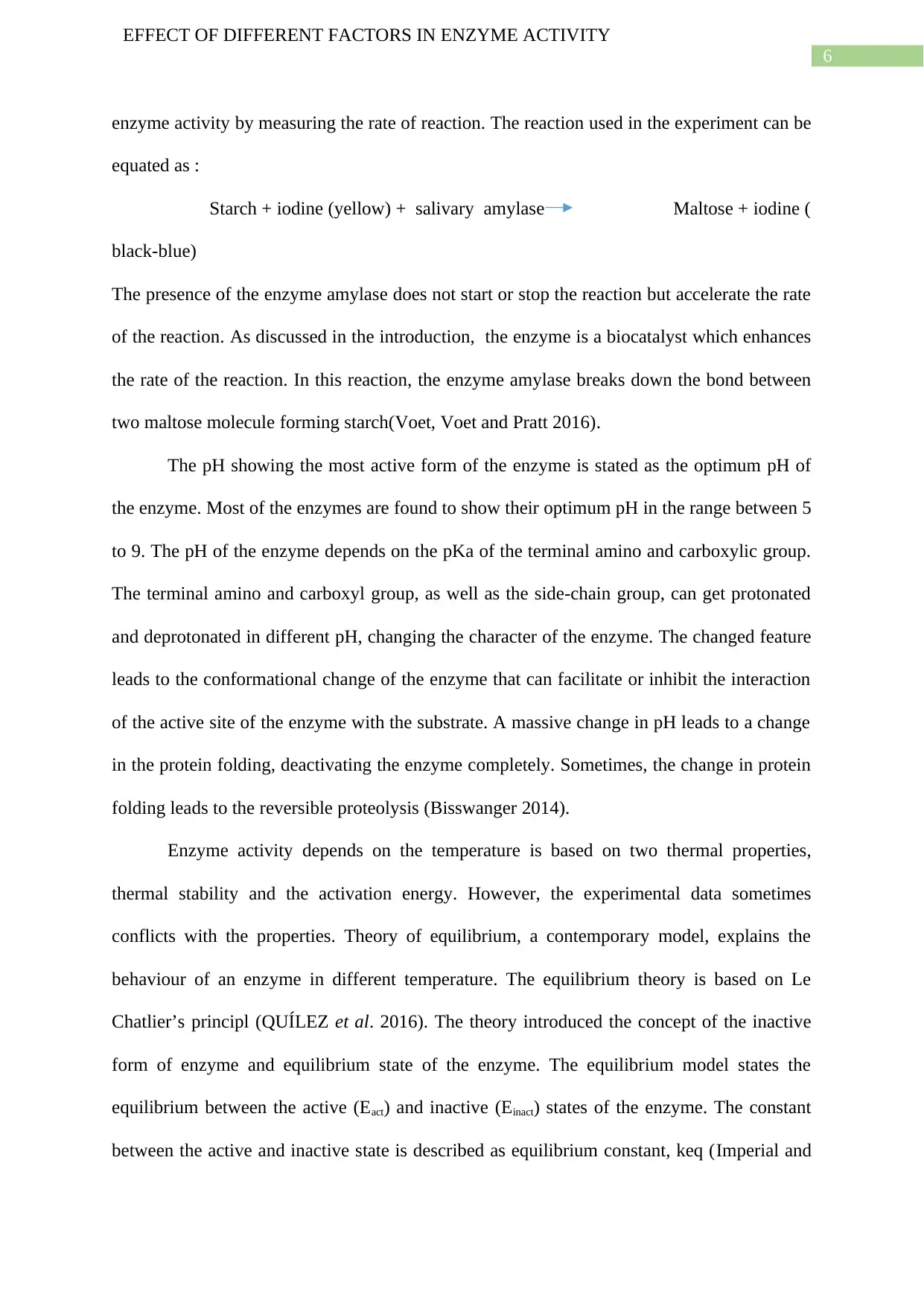
6
EFFECT OF DIFFERENT FACTORS IN ENZYME ACTIVITY
enzyme activity by measuring the rate of reaction. The reaction used in the experiment can be
equated as :
Starch + iodine (yellow) + salivary amylase Maltose + iodine (
black-blue)
The presence of the enzyme amylase does not start or stop the reaction but accelerate the rate
of the reaction. As discussed in the introduction, the enzyme is a biocatalyst which enhances
the rate of the reaction. In this reaction, the enzyme amylase breaks down the bond between
two maltose molecule forming starch(Voet, Voet and Pratt 2016).
The pH showing the most active form of the enzyme is stated as the optimum pH of
the enzyme. Most of the enzymes are found to show their optimum pH in the range between 5
to 9. The pH of the enzyme depends on the pKa of the terminal amino and carboxylic group.
The terminal amino and carboxyl group, as well as the side-chain group, can get protonated
and deprotonated in different pH, changing the character of the enzyme. The changed feature
leads to the conformational change of the enzyme that can facilitate or inhibit the interaction
of the active site of the enzyme with the substrate. A massive change in pH leads to a change
in the protein folding, deactivating the enzyme completely. Sometimes, the change in protein
folding leads to the reversible proteolysis (Bisswanger 2014).
Enzyme activity depends on the temperature is based on two thermal properties,
thermal stability and the activation energy. However, the experimental data sometimes
conflicts with the properties. Theory of equilibrium, a contemporary model, explains the
behaviour of an enzyme in different temperature. The equilibrium theory is based on Le
Chatlier’s principl (QUÍLEZ et al. 2016). The theory introduced the concept of the inactive
form of enzyme and equilibrium state of the enzyme. The equilibrium model states the
equilibrium between the active (Eact) and inactive (Einact) states of the enzyme. The constant
between the active and inactive state is described as equilibrium constant, keq (Imperial and
EFFECT OF DIFFERENT FACTORS IN ENZYME ACTIVITY
enzyme activity by measuring the rate of reaction. The reaction used in the experiment can be
equated as :
Starch + iodine (yellow) + salivary amylase Maltose + iodine (
black-blue)
The presence of the enzyme amylase does not start or stop the reaction but accelerate the rate
of the reaction. As discussed in the introduction, the enzyme is a biocatalyst which enhances
the rate of the reaction. In this reaction, the enzyme amylase breaks down the bond between
two maltose molecule forming starch(Voet, Voet and Pratt 2016).
The pH showing the most active form of the enzyme is stated as the optimum pH of
the enzyme. Most of the enzymes are found to show their optimum pH in the range between 5
to 9. The pH of the enzyme depends on the pKa of the terminal amino and carboxylic group.
The terminal amino and carboxyl group, as well as the side-chain group, can get protonated
and deprotonated in different pH, changing the character of the enzyme. The changed feature
leads to the conformational change of the enzyme that can facilitate or inhibit the interaction
of the active site of the enzyme with the substrate. A massive change in pH leads to a change
in the protein folding, deactivating the enzyme completely. Sometimes, the change in protein
folding leads to the reversible proteolysis (Bisswanger 2014).
Enzyme activity depends on the temperature is based on two thermal properties,
thermal stability and the activation energy. However, the experimental data sometimes
conflicts with the properties. Theory of equilibrium, a contemporary model, explains the
behaviour of an enzyme in different temperature. The equilibrium theory is based on Le
Chatlier’s principl (QUÍLEZ et al. 2016). The theory introduced the concept of the inactive
form of enzyme and equilibrium state of the enzyme. The equilibrium model states the
equilibrium between the active (Eact) and inactive (Einact) states of the enzyme. The constant
between the active and inactive state is described as equilibrium constant, keq (Imperial and
Paraphrase This Document
Need a fresh take? Get an instant paraphrase of this document with our AI Paraphraser
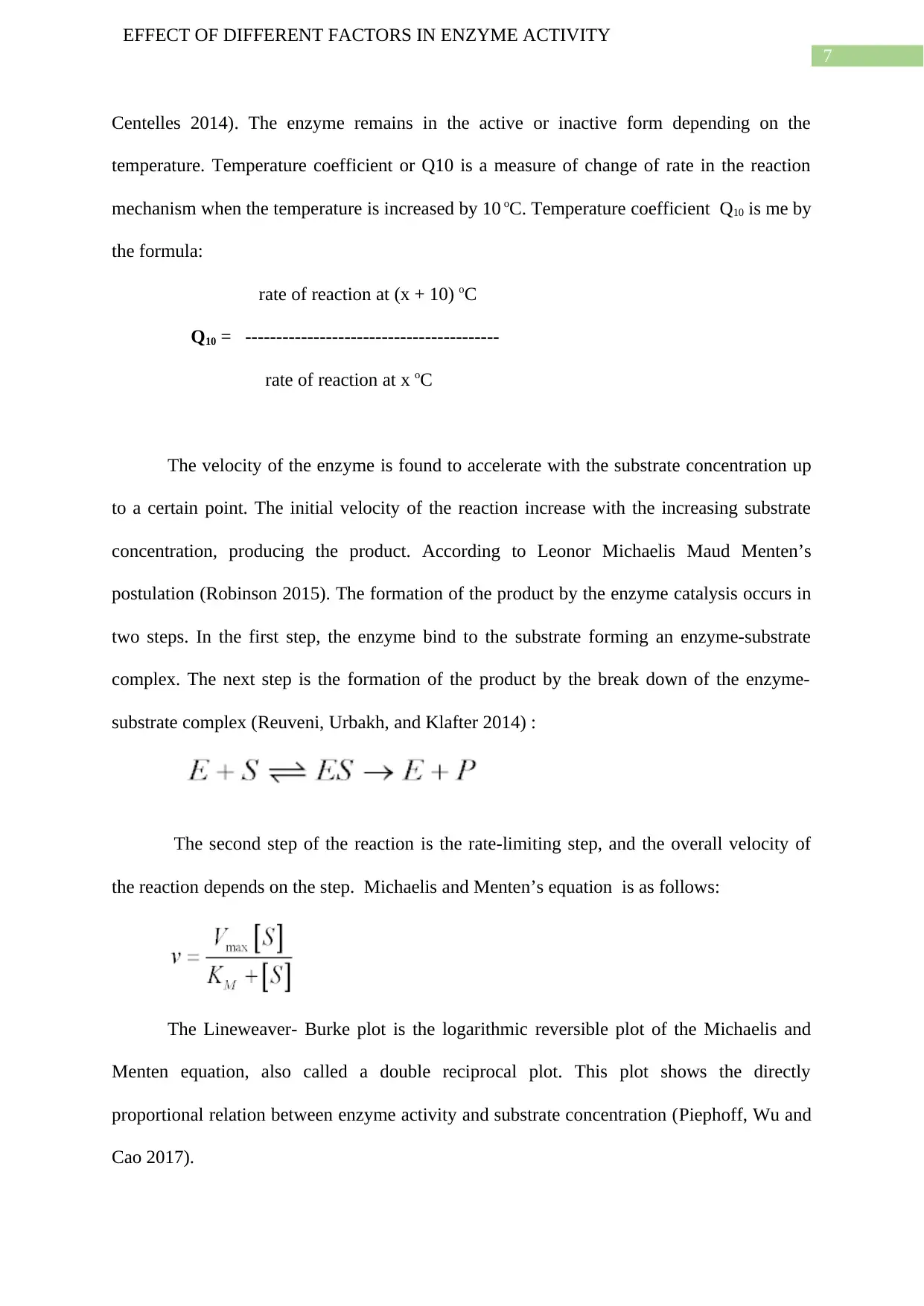
7
EFFECT OF DIFFERENT FACTORS IN ENZYME ACTIVITY
Centelles 2014). The enzyme remains in the active or inactive form depending on the
temperature. Temperature coefficient or Q10 is a measure of change of rate in the reaction
mechanism when the temperature is increased by 10 oC. Temperature coefficient Q10 is me by
the formula:
rate of reaction at (x + 10) oC
Q10 = -----------------------------------------
rate of reaction at x oC
The velocity of the enzyme is found to accelerate with the substrate concentration up
to a certain point. The initial velocity of the reaction increase with the increasing substrate
concentration, producing the product. According to Leonor Michaelis Maud Menten’s
postulation (Robinson 2015). The formation of the product by the enzyme catalysis occurs in
two steps. In the first step, the enzyme bind to the substrate forming an enzyme-substrate
complex. The next step is the formation of the product by the break down of the enzyme-
substrate complex (Reuveni, Urbakh, and Klafter 2014) :
The second step of the reaction is the rate-limiting step, and the overall velocity of
the reaction depends on the step. Michaelis and Menten’s equation is as follows:
The Lineweaver- Burke plot is the logarithmic reversible plot of the Michaelis and
Menten equation, also called a double reciprocal plot. This plot shows the directly
proportional relation between enzyme activity and substrate concentration (Piephoff, Wu and
Cao 2017).
EFFECT OF DIFFERENT FACTORS IN ENZYME ACTIVITY
Centelles 2014). The enzyme remains in the active or inactive form depending on the
temperature. Temperature coefficient or Q10 is a measure of change of rate in the reaction
mechanism when the temperature is increased by 10 oC. Temperature coefficient Q10 is me by
the formula:
rate of reaction at (x + 10) oC
Q10 = -----------------------------------------
rate of reaction at x oC
The velocity of the enzyme is found to accelerate with the substrate concentration up
to a certain point. The initial velocity of the reaction increase with the increasing substrate
concentration, producing the product. According to Leonor Michaelis Maud Menten’s
postulation (Robinson 2015). The formation of the product by the enzyme catalysis occurs in
two steps. In the first step, the enzyme bind to the substrate forming an enzyme-substrate
complex. The next step is the formation of the product by the break down of the enzyme-
substrate complex (Reuveni, Urbakh, and Klafter 2014) :
The second step of the reaction is the rate-limiting step, and the overall velocity of
the reaction depends on the step. Michaelis and Menten’s equation is as follows:
The Lineweaver- Burke plot is the logarithmic reversible plot of the Michaelis and
Menten equation, also called a double reciprocal plot. This plot shows the directly
proportional relation between enzyme activity and substrate concentration (Piephoff, Wu and
Cao 2017).
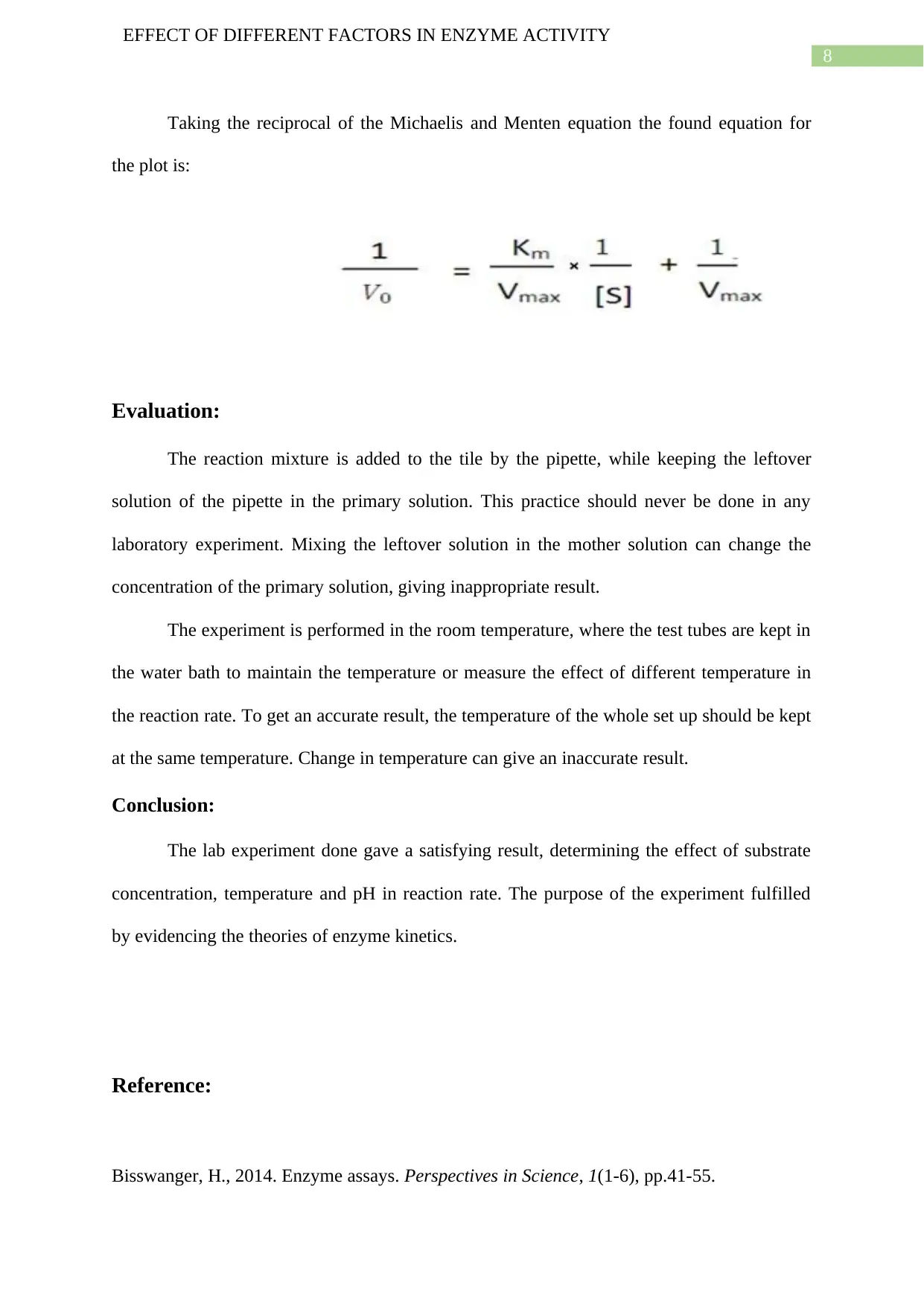
8
EFFECT OF DIFFERENT FACTORS IN ENZYME ACTIVITY
Taking the reciprocal of the Michaelis and Menten equation the found equation for
the plot is:
Evaluation:
The reaction mixture is added to the tile by the pipette, while keeping the leftover
solution of the pipette in the primary solution. This practice should never be done in any
laboratory experiment. Mixing the leftover solution in the mother solution can change the
concentration of the primary solution, giving inappropriate result.
The experiment is performed in the room temperature, where the test tubes are kept in
the water bath to maintain the temperature or measure the effect of different temperature in
the reaction rate. To get an accurate result, the temperature of the whole set up should be kept
at the same temperature. Change in temperature can give an inaccurate result.
Conclusion:
The lab experiment done gave a satisfying result, determining the effect of substrate
concentration, temperature and pH in reaction rate. The purpose of the experiment fulfilled
by evidencing the theories of enzyme kinetics.
Reference:
Bisswanger, H., 2014. Enzyme assays. Perspectives in Science, 1(1-6), pp.41-55.
EFFECT OF DIFFERENT FACTORS IN ENZYME ACTIVITY
Taking the reciprocal of the Michaelis and Menten equation the found equation for
the plot is:
Evaluation:
The reaction mixture is added to the tile by the pipette, while keeping the leftover
solution of the pipette in the primary solution. This practice should never be done in any
laboratory experiment. Mixing the leftover solution in the mother solution can change the
concentration of the primary solution, giving inappropriate result.
The experiment is performed in the room temperature, where the test tubes are kept in
the water bath to maintain the temperature or measure the effect of different temperature in
the reaction rate. To get an accurate result, the temperature of the whole set up should be kept
at the same temperature. Change in temperature can give an inaccurate result.
Conclusion:
The lab experiment done gave a satisfying result, determining the effect of substrate
concentration, temperature and pH in reaction rate. The purpose of the experiment fulfilled
by evidencing the theories of enzyme kinetics.
Reference:
Bisswanger, H., 2014. Enzyme assays. Perspectives in Science, 1(1-6), pp.41-55.
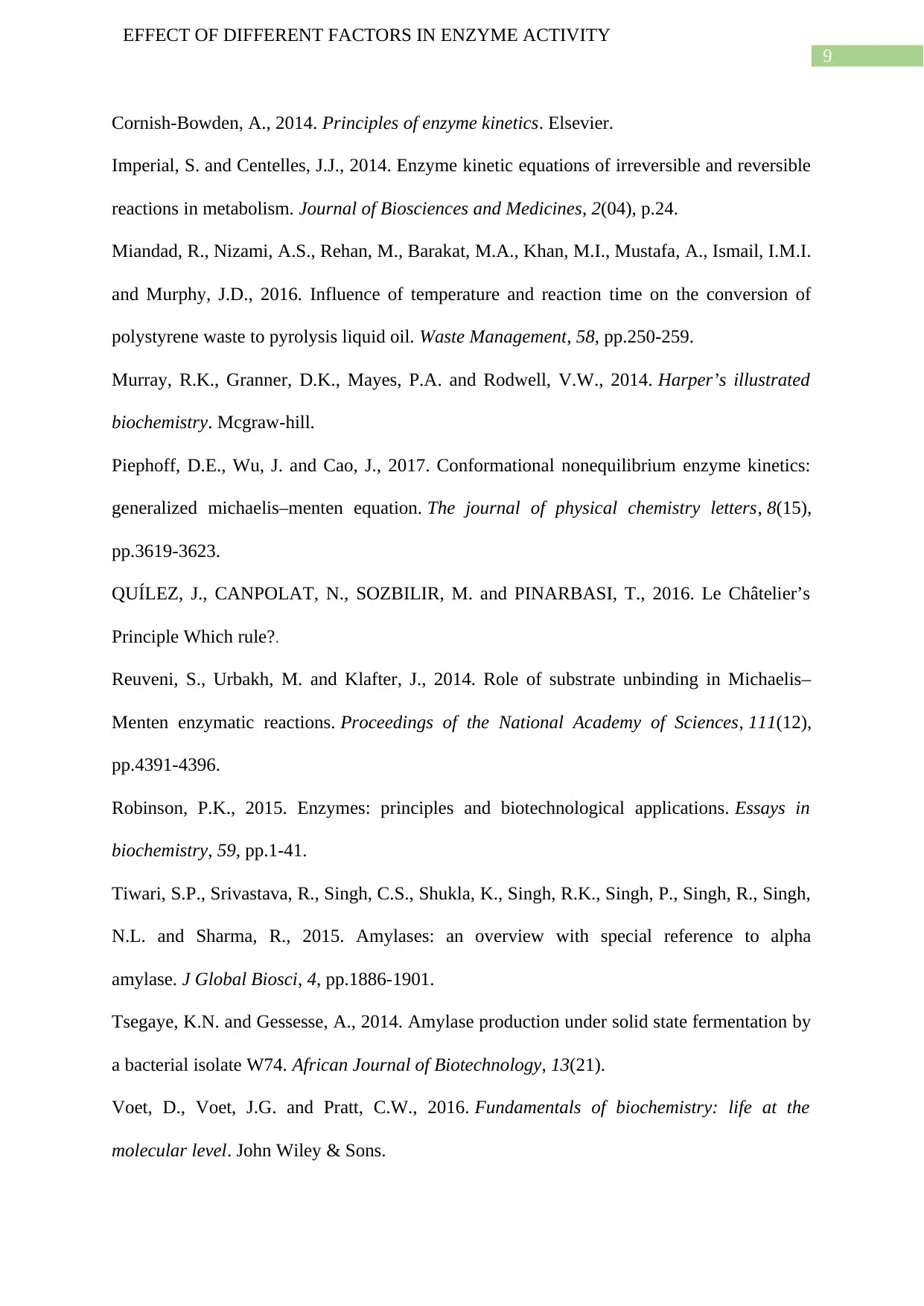
9
EFFECT OF DIFFERENT FACTORS IN ENZYME ACTIVITY
Cornish-Bowden, A., 2014. Principles of enzyme kinetics. Elsevier.
Imperial, S. and Centelles, J.J., 2014. Enzyme kinetic equations of irreversible and reversible
reactions in metabolism. Journal of Biosciences and Medicines, 2(04), p.24.
Miandad, R., Nizami, A.S., Rehan, M., Barakat, M.A., Khan, M.I., Mustafa, A., Ismail, I.M.I.
and Murphy, J.D., 2016. Influence of temperature and reaction time on the conversion of
polystyrene waste to pyrolysis liquid oil. Waste Management, 58, pp.250-259.
Murray, R.K., Granner, D.K., Mayes, P.A. and Rodwell, V.W., 2014. Harper’s illustrated
biochemistry. Mcgraw-hill.
Piephoff, D.E., Wu, J. and Cao, J., 2017. Conformational nonequilibrium enzyme kinetics:
generalized michaelis–menten equation. The journal of physical chemistry letters, 8(15),
pp.3619-3623.
QUÍLEZ, J., CANPOLAT, N., SOZBILIR, M. and PINARBASI, T., 2016. Le Châtelier’s
Principle Which rule?.
Reuveni, S., Urbakh, M. and Klafter, J., 2014. Role of substrate unbinding in Michaelis–
Menten enzymatic reactions. Proceedings of the National Academy of Sciences, 111(12),
pp.4391-4396.
Robinson, P.K., 2015. Enzymes: principles and biotechnological applications. Essays in
biochemistry, 59, pp.1-41.
Tiwari, S.P., Srivastava, R., Singh, C.S., Shukla, K., Singh, R.K., Singh, P., Singh, R., Singh,
N.L. and Sharma, R., 2015. Amylases: an overview with special reference to alpha
amylase. J Global Biosci, 4, pp.1886-1901.
Tsegaye, K.N. and Gessesse, A., 2014. Amylase production under solid state fermentation by
a bacterial isolate W74. African Journal of Biotechnology, 13(21).
Voet, D., Voet, J.G. and Pratt, C.W., 2016. Fundamentals of biochemistry: life at the
molecular level. John Wiley & Sons.
EFFECT OF DIFFERENT FACTORS IN ENZYME ACTIVITY
Cornish-Bowden, A., 2014. Principles of enzyme kinetics. Elsevier.
Imperial, S. and Centelles, J.J., 2014. Enzyme kinetic equations of irreversible and reversible
reactions in metabolism. Journal of Biosciences and Medicines, 2(04), p.24.
Miandad, R., Nizami, A.S., Rehan, M., Barakat, M.A., Khan, M.I., Mustafa, A., Ismail, I.M.I.
and Murphy, J.D., 2016. Influence of temperature and reaction time on the conversion of
polystyrene waste to pyrolysis liquid oil. Waste Management, 58, pp.250-259.
Murray, R.K., Granner, D.K., Mayes, P.A. and Rodwell, V.W., 2014. Harper’s illustrated
biochemistry. Mcgraw-hill.
Piephoff, D.E., Wu, J. and Cao, J., 2017. Conformational nonequilibrium enzyme kinetics:
generalized michaelis–menten equation. The journal of physical chemistry letters, 8(15),
pp.3619-3623.
QUÍLEZ, J., CANPOLAT, N., SOZBILIR, M. and PINARBASI, T., 2016. Le Châtelier’s
Principle Which rule?.
Reuveni, S., Urbakh, M. and Klafter, J., 2014. Role of substrate unbinding in Michaelis–
Menten enzymatic reactions. Proceedings of the National Academy of Sciences, 111(12),
pp.4391-4396.
Robinson, P.K., 2015. Enzymes: principles and biotechnological applications. Essays in
biochemistry, 59, pp.1-41.
Tiwari, S.P., Srivastava, R., Singh, C.S., Shukla, K., Singh, R.K., Singh, P., Singh, R., Singh,
N.L. and Sharma, R., 2015. Amylases: an overview with special reference to alpha
amylase. J Global Biosci, 4, pp.1886-1901.
Tsegaye, K.N. and Gessesse, A., 2014. Amylase production under solid state fermentation by
a bacterial isolate W74. African Journal of Biotechnology, 13(21).
Voet, D., Voet, J.G. and Pratt, C.W., 2016. Fundamentals of biochemistry: life at the
molecular level. John Wiley & Sons.
Secure Best Marks with AI Grader
Need help grading? Try our AI Grader for instant feedback on your assignments.

10
EFFECT OF DIFFERENT FACTORS IN ENZYME ACTIVITY
EFFECT OF DIFFERENT FACTORS IN ENZYME ACTIVITY
1 out of 11
Related Documents
Your All-in-One AI-Powered Toolkit for Academic Success.
+13062052269
info@desklib.com
Available 24*7 on WhatsApp / Email
![[object Object]](/_next/static/media/star-bottom.7253800d.svg)
Unlock your academic potential
© 2024 | Zucol Services PVT LTD | All rights reserved.



